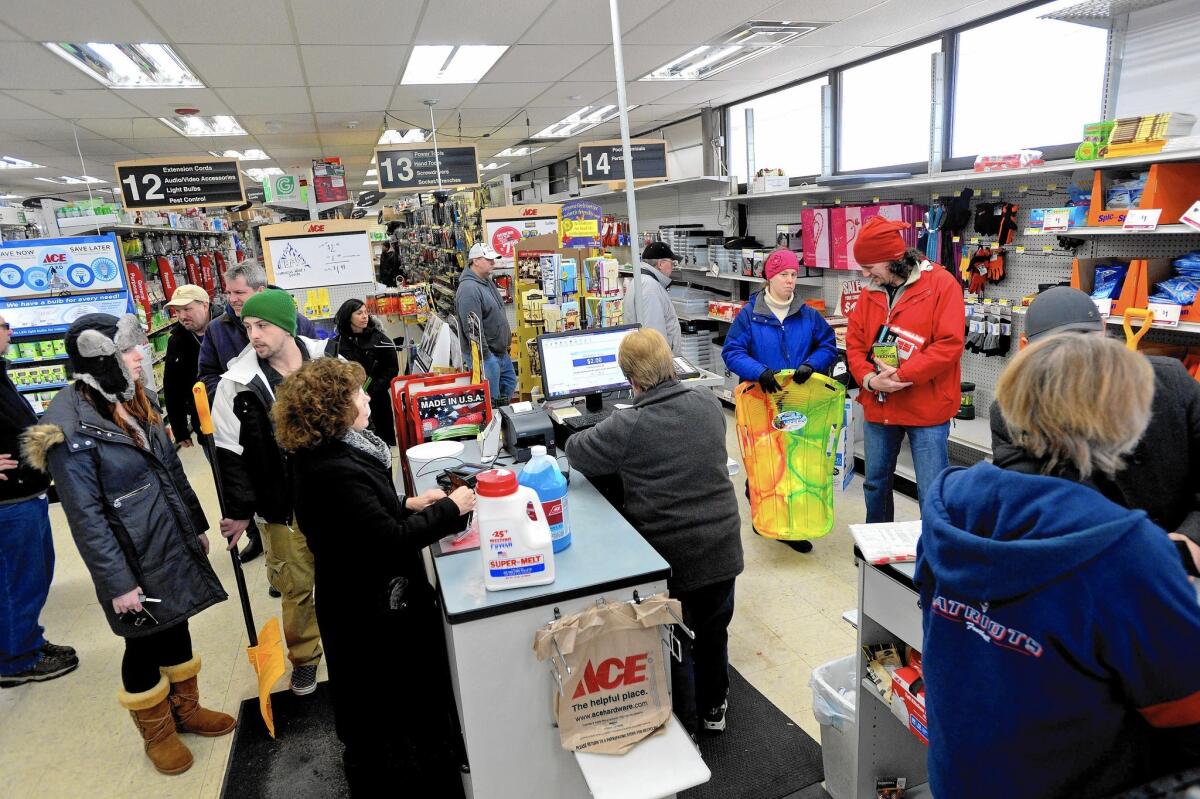Economy shrinks in first quarter for second straight year

- Share via
WASHINGTON — The economy shrank in the first quarter for the second straight year, and some of the problems could linger into the summer, demonstrating the continuing weakness of the recovery from the Great Recession.
Total economic output, also known as gross domestic product, decreased at a 0.7% annual rate from January through March, the Commerce Department said Friday, as severe weather in the Northeast and Midwest combined with the West Coast ports dispute and the soaring U.S. dollar to smother growth.
The performance was worse than last month’s initial estimate of 0.2% annual growth and down sharply from the 2.2% growth rate in the fourth quarter.
Bad winter weather, which kept consumers at home and delayed construction projects, pushed the economy into negative territory as it did last year.
“It just shows you how delicate and fragile the U.S. economy still is that even a tiny gust of wind can blow it over,” said Lindsey Piegza, chief economist at brokerage Sterne Agee.
Economists aren’t worried about another recession, noting that temporary factors and potential problems with seasonal adjustments in the data were key factors in the first-quarter contraction. They expect growth to return in the second quarter, though at a sluggish pace of no more than 2%.
“The transitory conditions that depressed first-quarter growth will reverse in the second quarter with more normal weather and as the effects of the port disruptions diminish,” said Nariman Behravesh, chief economist IHS Global Insight.
But other problems for the economy, including a strong dollar that makes U.S. exports more expensive abroad, “will depress growth at least into the summer,” he said, adding that a 2% rate would be “barely above mediocre.”
Piegza isn’t even that optimistic. She’s forecasting a second-quarter growth rate of 1.5%, which would make the first half of this year the worst since the Great Recession ended.
The new Commerce Department data make it unlikely that the Federal Reserve will raise a key interest rate in June, economists said. Some analysts predicted that the first rate hike since 2006, which would signal that central bank policymakers believe the economy is on solid footing, now won’t happen until at least late this year.
The federal funds rate, a key short-term benchmark, has been near zero percent since late 2008 in an effort to stimulate spending.
As the economy strengthened last year, the Fed began signaling that it was ready to start raising rates.
But the first quarter was the worst since the economy shrank 2.1% in the first three months of 2014, largely because of even more severe winter weather.
Friday’s downward revision was caused by more imports than initially estimated and less spending by businesses to expand their inventories, the Commerce Department said.
Those were on top of a sharp slowdown in the growth of consumer spending, which rose just 1.8% in the first quarter compared with 4.4% in the fourth quarter.
Consumers are paying less for gasoline than a year ago because of the decline in oil prices. But they’re hesitant to spend those savings given the sluggish economy, said Brian Bethune, chief economist at Alpha Economic Foresights.
The percentage of disposable income saved by consumers jumped to 5.5% in the first quarter from 4.7% the previous quarter.
“There’s nothing to suggest that consumer spending activity is poised to accelerate,” Bethune said. “Consumers are being conservative.”
Imports surged in March because many container ships were delayed in unloading their cargo in the first two months of the year by a labor dispute at the ports of Los Angeles and Long Beach as well as elsewhere on the West Coast.
The rising value of the dollar against other currencies also made imports less expensive while increasing the costs for foreigners to purchase U.S. goods. The trade deficit swelled in March to its largest gap since 2008.
The downbeat data weighed on investors. The Dow Jones industrial average fell 115.44 points, or 0.6%, to 18,010.68 on Friday.
The White House sought to ease concerns about the economy.
“The first-quarter slowdown was the result of harsh winter weather, tepid foreign demand and consumers saving the windfall from lower oil prices,” said Jason Furman, chairman of the White House Council of Economic Advisors.
He cautioned against reading too much into one quarter’s data, saying that consumer spending and business investment were up a combined 3.4% over the 12 months that ended March 31 and that job growth has been solid.
Furman also noted that growth has been “considerably slower” on average in the first quarter over the last decade than in the other quarters. The only three contractions since the Great Recession all took place in the first quarters of the year.
Some other economists have pointed to the pattern and have questioned whether the Commerce Department was properly adjusting its data for seasonal changes, such as the annual cutbacks in extra workers hired for the Christmas holiday season.
In response to questions about the accuracy of first-quarter economic data, the Bureau of Economic Analysis, the Commerce Department division that calculates economic growth, said last week that it would review how it applies so-called seasonal adjustments.
The bureau said changes in seasonal patterns could lead to what it called “residual seasonality” — the continued influence of those patterns in data that already had been adjusted to take them into account.
The announcement came after researchers at the Federal Reserve Bank of San Francisco said that there was “a good chance the underlying economic growth so far this year was substantially stronger than reported.”
More to Read
Inside the business of entertainment
The Wide Shot brings you news, analysis and insights on everything from streaming wars to production — and what it all means for the future.
You may occasionally receive promotional content from the Los Angeles Times.











